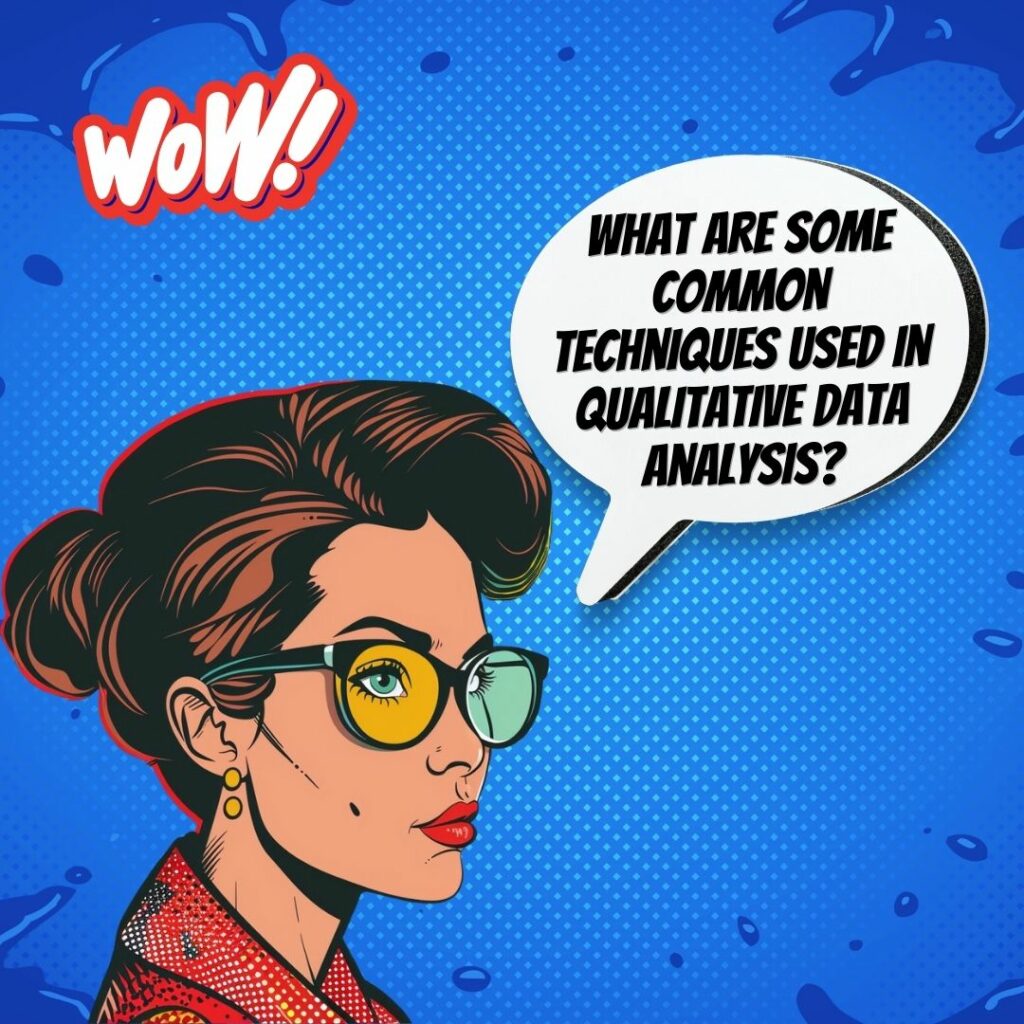Key Takeaways
✅ Flexibility in Approach: Remember that trusty toolbox in your shed? Well, think of Qualitative Data Analysis (QDA) like that, but for your research. It’s chock-full of different methods ready to tackle the unique twists and turns of human behavior. It’s not a one-size-fits-all; it’s tailored to fit the story hiding in your data.
✅ Diverse Analytical Techniques: Now, you wouldn’t use a hammer for a screw, right? Just like that, QDA isn’t about pounding data into submission; it’s about finding the right technique—be it content analysis or narrative inquiry—to gently uncover the patterns and themes that are playing hide and seek.
✅ Technological Advancements: Ever felt like you’re drowning in data? Good news: there are life rafts! Tools like NVivo and Atlas.ti are here to save the day, helping you swim through the data sea more efficiently and, let’s be honest, with a lot fewer headaches.

Introduction
Ever stumbled upon a treasure map with no X marking the spot? That’s what diving into qualitative data can feel like. There’s treasure there, alright. But how do you find it? And once you’ve dug it up, how do you know it’s worth its weight in gold—or just shiny pebbles? This article is for anyone who’s ever been curious, frustrated, or just plain intrigued by the rich and tangled world of words, images, and stories. Stay put, because we’re about to unveil some pretty sweet insights and techniques that could turn your research into the stuff of legends.
Alright, keep your hats on—we’re about to hop on this rollercoaster ride through fascinating methods, nifty tools, and life-saving tips to make sure your qualitative research is as solid as an old oak tree. And let me tell you, by the end of this, you’ll be wielding those tools like a pro, finding the key to unlock the true potential of your data, and maybe, just maybe, a bit of wisdom to boot. Let’s get to it!
Top Statistics
| Statistic | Insight |
|---|---|
| Global Qualitative Research Software Market Size: Valued at $637.9 million in 2019, with an expected CAGR of 8.5% from 2020 to 2027. (Source: Grand View Research) | This growth suggests a robust demand for in-depth insight into the qualitative aspect of data, vital for businesses looking to understand customer narratives more deeply. |
| Largest Market Share: North America holding a 41% share in 2020. (Source: MarketWatch) | Highlights North America as a key player; companies in this region are eager for tools to make sense of vast amounts of qualitative information. |
| Top End Users: Academic institutions (over 25% of total revenue) and healthcare organizations. (Source: Grand View Research) | The dominance of academia and healthcare indicates these sectors’ reliance on qualitative analysis for research advancements and patient care strategies. |
| User Demographics: Researchers, analysts, and marketing professionals. (Source: MarketWatch) | These professionals are the backbone of data interpretation, driving the need for innovative solutions in qualitative software. |
| AI and Cloud-Based Tools Demand: Rising due to benefits like flexibility and scalability. (Source: Verified Market Research) | Cloud and AI technologies are reshaping how qualitative data is analyzed, providing more dynamic and efficient research capabilities. |
Understanding Qualitative Data Analysis
1. Preparing Data for Analysis
Before any real magic can happen with qualitative data, you need to lay the groundwork. Wondering how? Imagine you’re cooking a real feast—that first step is crucial, right? Similarly, transcribing every grunt, sigh, and word from audio recordings is essential because those little details can speak volumes. Then, there’s coding—think of it as sorting ingredients into the right bowls before you start cooking. By assigning labels to specific parts of the data, researchers can easily sift through immense amounts of information and uncover surprising patterns. Can coding your data really make that difference? Absolutely—and it’s just the beginning.
2. Qualitative Data Analysis Techniques
Just like different chefs have their special recipes, researchers have their unique methods to dissect qualitative data. Grounded theory has you play detective, looking at each clue and deciding where it fits to create a bigger picture. Think of thematic analysis as creating a map from stories, one where common landmarks pop up, showing you the way. With content analysis, it’s a bit like counting the beans, but also knowing each bean’s flavor—measuring the words while discovering the underlying meaning. And narrative analysis? That’s your deep dive into personal tales, understanding the twists and nuances of each plot.
3. Qualitative Data Analysis Tools
Choosing tools for qualitative data analysis is like picking the right paintbrush for a masterpiece. Sure, you could use your hands, but why not make it easier? Old-school tools like highlighters may seem archaic, but some swear by them for their tactile feel. And then, softwares like NVivo and MAXQDA step in as the heavy artillery, offering efficiency and organization but sometimes at the cost of a steep learning curve. The question to ponder is this: when does a tool bolster your analysis, and when does it become a crutch?
4. Ensuring Rigor in Qualitative Research
How do you ensure that your hard-earned research stands on a solid foundation? Imagine building a house—you wouldn’t just trust that it’s strong, you’d want proof, right? In qualitative research, we strive for credibility and transferability, guaranteeing that others can see the value and apply it to different contexts. Techniques like member checking, where participants validate the findings, reinforce this rigor, acting much like an inspector reviewing your work. Add a dash of reflexivity, where you examine your own biases, and you’re on your way to crafting research that truly stands up to scrutiny.
AI Marketing Engineers Recommendation
Recommendation 1: Utilize Storytelling in Gathering Qualitative Data: Empower your team to collect qualitative data through the art of storytelling. Encourage customers to share their experiences with your product or service as a narrative. This approach tends to reveal the emotional context and deeper insights you might miss with traditional surveys. These stories can unveil those crucial points that data points and numbers just don’t tell you. After all, isn’t it true that behind every customer action, there’s a story waiting to be heard?
Recommendation 2: Combine AI with Traditional Qualitative Techniques to Enhance Data Interpretation: Leverage the latest artificial intelligence (AI) tools to analyze language and emotion in qualitative data. These advanced systems can sift through customer feedback, spot patterns, and even detect sentiment nuances that might go unnoticed by human analysts. As we know, the digital world is buzzing with conversations – so why not use AI to help pinpoint exactly what resonates with your audience?
Recommendation 3: Adopt Interactive Qualitative Analysis Tools for Real-time Feedback: Integrate interactive tools such as online focus groups or mobile diary studies to gather and analyze qualitative data in real-time. These platforms allow for immediate engagement and can help you understand the context behind user decisions while the memory is still fresh. Imagine being able to tweak your campaign on-the-fly based on what customers are telling you right this second – could that be the edge your brand needs?
Conclusion
So, we’ve strolled down the path of qualitative data analysis together. Have you ever stopped to think about the stories behind the numbers? How people feel and think about things? That’s the rich soil where qualitative data blooms. We’ve touched on some solid methods that are like treasure maps to uncovering human experiences—everything from diving into conversations through interviews to joining groups, observing in the trenches, and sifting through documents.
Now, what’s the point of gathering all these colorful threads if we can’t weave them into insights, right? That’s where our tapestry of techniques comes in—grounded theory, thematic analysis, narrative adventures, and so much more. And let’s not forget about our companions on this journey, the tools that help us sort, categorize, and make sense of it all. Sure, we can stick to the classic pen and paper, color-coded systems, or we can leap into the digital age with CAQDAS.
Nonetheless, remember that magic word – rigor. It’s not just about collecting stories; it’s about doing it right—being credible, dependable, and reflective. Combine all these elements, and you’ve got yourself not just data, but knowledge—knowledge that can transform understanding, decisions, and maybe even the world.
Now, tell me, aren’t you a bit curious to try it out for yourself? To really listen to what people have to say and let their words guide you to those aha! moments? Whether it’s your next market research or understanding a community, the power of qualitative data analysis is immense. It’s about getting to the heart of the matter, the human element in our data-driven universe. So go on, grasp these techniques and tools, ensure rigor, and unlock the stories that numbers alone can’t tell. Who knows, perhaps that next insight is just around the corner, waiting for you to discover it. Ready to unlock it?
FAQs
Question 1: What is qualitative data analysis?
Answer: Imagine you’re listening to people’s stories, looking at their photos, or watching videos to really understand what they’re all about. Qualitative data analysis is just that—it’s about diving into all the non-number stuff to figure out what makes people tick.
Question 2: Why is qualitative data analysis important in research?
Answer: Think of it as the colors that fill in a black and white sketch. Qualitative data analysis paints the full picture, giving context and depth to the numbers. It’s the key to grasping the ‘why’ and ‘how’ behind what people do.
Question 3: What are common techniques used in qualitative data analysis?
Answer: There’s a whole palette of methods like peeling back the layers of a story (thematic analysis), digging into conversations (discourse analysis), or walking a mile in someone else’s shoes (phenomenological analysis). Each technique lets you explore data in different ways.
Question 4: How do I choose an appropriate technique for my qualitative study?
Answer: It’s a bit like picking the right tool for a job. Ask yourself: What’s my question? What kind of information have I got? What’s my goal? Your answers to these questions guide you in selecting the technique that suits your research best.
Question 5: Can I use software tools for qualitative data analysis?
Answer: Absolutely! Just as a carpenter uses tools to craft wood, researchers have digital tools like NVivo or ATLAS.ti to sort through and make sense of heaps of qualitative data. These programs can be real lifesavers.
Question 6: How do I ensure rigor in qualitative data analysis?
Answer: Rigor is about being thorough and conscientious. Be clear about how you analyze, check in with your biases, and aim to have genuine discussions with your participants. Think of it like double-checking your work to make sure it’s solid.
Question 7: How do I handle large volumes of qualitative data?
Answer: It’s like tidying up a cluttered room. Break your data into sections, label them, and use tools to help you keep track. Team up with others to share the load and have a clear plan to tackle the data one piece at a time.
Question 8: What are some common challenges in qualitative data analysis?
Answer: It can get tricky. You’ve got mountains of words or images to sort, your own viewpoint can sneak into the analysis, and sometimes the story you find is so rich it’s hard to tell it simply. But these challenges also make the work really exciting.
Question 9: Can qualitative data be trusted as much as quantitative data?
Answer: You bet. Imagine if you only knew someone’s height and favorite color—you’d be missing so much about who they are! Qualitative data fills in the blanks. Both types are trustworthy when used in the right way for the right reasons.
Question 10: Where can I learn more about advanced topics in qualitative data analysis?
Answer: It’s like going deeper into a forest—there’s so much to explore. You could delve into academic journals, soak up wisdom from qualitative research experts, or join gatherings of curious minds at workshops or conferences.
Academic References
- Miles, M. B., Huberman, A. M., & Saldana, J. (2014). Qualitative Data Analysis: An Expanded Sourcebook (2nd ed.). This comprehensive guide is the bedrock for anyone wading through qualitative data. It’s like having a Swiss Army knife for data analysis, providing techniques such as coding and drawing out visual maps of thoughts. Here’s the cool part: it talks about ‘data management strategies’ to help you not drown in the sea of information. [ISBN-13: 978-1452257877]
- Charmaz, K. (2014). Doing Grounded Theory: A Practical Guide (Revised ed.). Ever felt like you’re panning for gold in a river of words? Kathy Charmaz hands you the pan and shows you how with her practical guide to qualitative research. The iterative cycle of data collection and analysis she describes will keep you on your toes, ensuring your research is as solid as the ground you walk on. [ISBN-13: 978-1473943582]
- Braun, V., & Clarke, V. (2006). Thematic Analysis. Qualitative Research in Psychology, 3(2), 77-101. This article is like a trusty flashlight guiding researchers through the dark woods of thematic analysis. These authors lay out a six-phase plan to keep your research honest and transparent. [ISSN 1478-0887]
- Jackson, K., & Bazeley, P. (2019). NVivo 12 Essentials (2nd ed.). Picture this: NVivo as a workshop full of tools—this book is the expert walking you through, showing you how to use each one. Essential read for anyone trying to make sense of qualitative data with NVivo’s help. [ISBN-13: 978-1789736396]
- Moustakas, C. (1994). Phenomenological Research Methods (2nd ed.). Clark Moustakas might as well be a wise sage when it comes to phenomenological research. His work may be older, but it’s like a fine wine, serving up timeless teachings about capturing the essence of human experience. His techniques of bracketing and horizonalization are like the lenses on a camera, focusing in on the heart of the subject. [ISBN-13: 978-0803957992]












